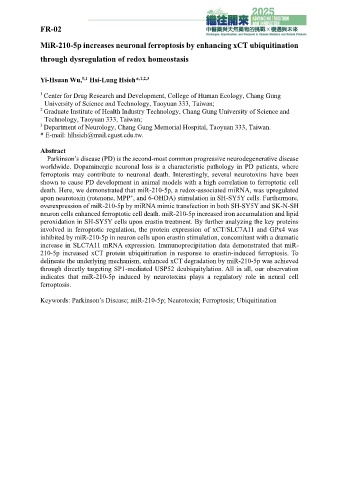Page 309 - 2025中醫藥與天然藥物聯合學術研討會-中醫藥與天然藥物的挑戰X機遇與未來大會手冊
P. 309
FR-02
MiR-210-5p increases neuronal ferroptosis by enhancing xCT ubiquitination
through dysregulation of redox homeostasis
#,1
Yi-Hsuan Wu, Hsi-Lung Hsieh* ,1,2,3
1 Center for Drug Research and Development, College of Human Ecology, Chang Gung
University of Science and Technology, Taoyuan 333, Taiwan;
2 Graduate Institute of Health Industry Technology, Chang Gung University of Science and
Technology, Taoyuan 333, Taiwan;
3 Department of Neurology, Chang Gung Memorial Hospital, Taoyuan 333, Taiwan.
* E-mail: hlhsieh@mail.cgust.edu.tw.
Abstract
Parkinson’s disease (PD) is the second-most common progressive neurodegenerative disease
worldwide. Dopaminergic neuronal loss is a characteristic pathology in PD patients, where
ferroptosis may contribute to neuronal death. Interestingly, several neurotoxins have been
shown to cause PD development in animal models with a high correlation to ferroptotic cell
death. Here, we demonstrated that miR-210-5p, a redox-associated miRNA, was upregulated
+
upon neurotoxin (rotenone, MPP , and 6-OHDA) stimulation in SH-SY5Y cells. Furthermore,
overexpression of miR-210-5p by miRNA mimic transfection in both SH-SY5Y and SK-N-SH
neuron cells enhanced ferroptotic cell death. miR-210-5p increased iron accumulation and lipid
peroxidation in SH-SY5Y cells upon erastin treatment. By further analyzing the key proteins
involved in ferroptotic regulation, the protein expression of xCT/SLC7A11 and GPx4 was
inhibited by miR-210-5p in neuron cells upon erastin stimulation, concomitant with a dramatic
increase in SLC7A11 mRNA expression. Immunoprecipitation data demonstrated that miR-
210-5p increased xCT protein ubiquitination in response to erastin-induced ferroptosis. To
delineate the underlying mechanism, enhanced xCT degradation by miR-210-5p was achieved
through directly targeting SP1-mediated USP52 deubiquitylation. All in all, our observation
indicates that miR-210-5p induced by neurotoxins plays a regulatory role in neural cell
ferroptosis.
Keywords: Parkinson’s Disease; miR-210-5p; Neurotoxin; Ferroptosis; Ubiquitination

